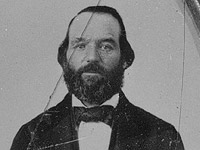Difference between revisions of "Edward Martin"
| Line 1: | Line 1: | ||
[[Image:Edward_Martin.jpg|300px|thumb|right]] | [[Image:Edward_Martin.jpg|300px|thumb|right]] | ||
| − | '''Edward Martin''' is well-known in the history of [http://comeuntochrist.org The Church of Jesus Christ of Latter-day Saints] as the man who served as captain of the [[Willie and Martin Handcart Companies|Martin Handcart Company]. [[Martin's Cove]], a place of refuge against the harsh Wyoming winter for his company, was named after him. | + | '''Edward Martin''' is well-known in the history of [http://comeuntochrist.org The Church of Jesus Christ of Latter-day Saints] as the man who served as captain of the [[Willie and Martin Handcart Companies|Martin Handcart Company]]. [[Martin's Cove]], a place of refuge against the harsh Wyoming winter for his company, was named after him. |
Martin was born on November 18, 1818, in Preston, England, and was baptized a member of the Church in the [[Ribble Valley|River Ribble]] by [[Orson Hyde]] on October 14, 1837. | Martin was born on November 18, 1818, in Preston, England, and was baptized a member of the Church in the [[Ribble Valley|River Ribble]] by [[Orson Hyde]] on October 14, 1837. | ||
Revision as of 12:19, 31 August 2023
Edward Martin is well-known in the history of The Church of Jesus Christ of Latter-day Saints as the man who served as captain of the Martin Handcart Company. Martin's Cove, a place of refuge against the harsh Wyoming winter for his company, was named after him.
Martin was born on November 18, 1818, in Preston, England, and was baptized a member of the Church in the River Ribble by Orson Hyde on October 14, 1837.
He worked as a journeyman house and interior painter in Scotland. After his marriage to Alice Clayton in March 1840, they immigrated to the United States, arriving in New Orleans before continuing on to Nauvoo. In February 1846, they left Nauvoo, where he had been ordained a Seventy, and traveled to Council Bluffs, Iowa.
Martin enlisted in the Mormon Battalion and served as a corporal and sergeant in Company C. He, like many others, was discharged after marching 1,500 miles to California in the war with Mexico. He walked back to Salt Lake with the Hancock, Hunt, Pace, and Lytle company but discovered that his family had not yet arrived. He consequently walked back to Council Bluffs to help them, arriving on December 10, 1847. He had walked over 6,000 miles since he left Nauvoo in February 1846.
The following year, he and his family traveled to Salt Lake with the Heber C. Kimball Company and arrived on September 24, 1848.
Four years later he embarked on a mission to England, serving from February 1852 to May 1856. After completing his mission, he left Liverpool on the ship Horizon, serving as captain of a company of 856 Latter-day Saints. After arriving in Boston, the company traveled by train to Iowa City, Iowa.
Martin was assigned as captain of the fifth handcart company, which consisted of 575 individuals. They departed on July 28, 1856, and, as is well-known, encountered early heavy snow as they traveled through Wyoming. Approximately 100 of his company lost their lives during the journey. He had kept a detailed account of all the members of his company in a journal, but that journal was accidentally burned.
After arriving in Salt Lake City, he practiced plural marriage. He worked as a painter and glazier at first and then later as a general store merchant and photographer. Most of his photographs were in the form of CdV (cartes de visite), a business card size, but he also took some panoramic views of Salt Lake Valley. “A collection now in the Church History Library contains twelve of Martin’s views of Salt Lake featuring the Lion House, the Council House, the Salt Lake Theatre, the temple construction site, and homes and businesses.”[1]
Perhaps due to competition with well-known photographers such as Charles R. Savage, Martin also worked as a real estate agent.
Edward Martin died on August 8, 1882, in Salt Lake City.
